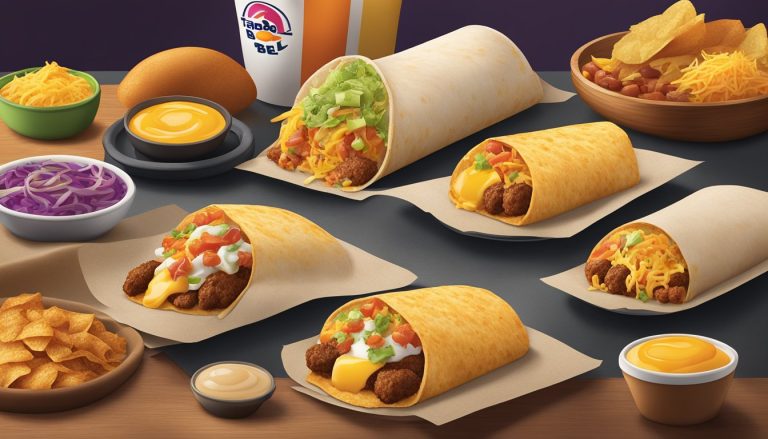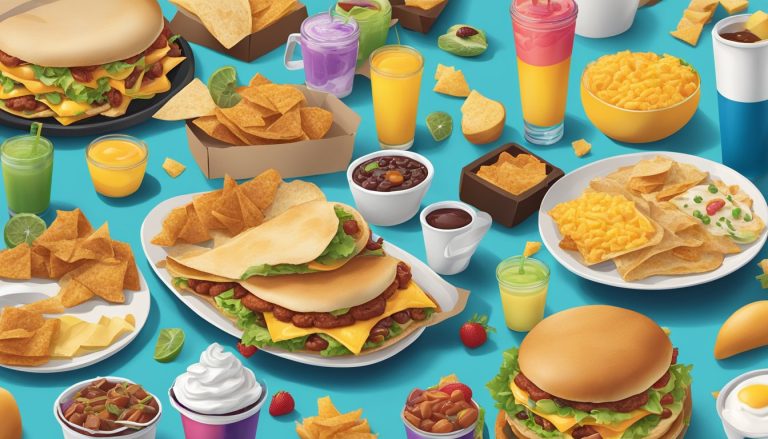Taco Bell’s breakfast offerings have undergone significant changes since their introduction in 2014. The fast-food chain has adapted its morning menu to meet evolving customer preferences and market demands. Taco Bell plans to focus on enhancing its coffee program and testing new breakfast items in company-owned stores, signaling a shift in its breakfast strategy.
The future of Taco Bell’s breakfast may involve a more streamlined menu with an emphasis on innovative, portable options. While some locations have scaled back their breakfast services, the company remains committed to the morning daypart. Taco Bell’s ability to create unique, craveable breakfast items has been a key factor in attracting customers during the early hours.
As consumer habits continue to change, Taco Bell is likely to experiment with new flavors and formats for its breakfast menu. The chain’s focus on affordability and convenience will likely remain central to its breakfast strategy. Taco Bell’s success in the breakfast market will depend on its ability to balance innovation with customer favorites and operational efficiency.
Historical Evolution of Taco Bell’s Breakfast Menu

Taco Bell’s breakfast journey began as a bold experiment and evolved into a key part of their menu offerings. The chain introduced innovative morning items that reshaped fast-food breakfast norms.
The Birth of Breakfast at Taco Bell
Taco Bell launched its first nationwide breakfast menu on March 27, 2014. This move marked a significant expansion for the brand, which had focused primarily on lunch and dinner options since its founding in 1962.
The initial breakfast lineup featured unique items like the Waffle Taco, a breakfast sandwich with eggs and cheese wrapped in a waffle. This creative approach set Taco Bell apart from traditional fast-food breakfast offerings.
Major Breakfast Milestones
The Breakfast Crunchwrap quickly became a signature item. This portable meal combined scrambled eggs, cheese, hash browns, and bacon or sausage in a grilled tortilla.
Taco Bell continued to innovate, introducing breakfast burritos and quesadillas. The chain also experimented with limited-time offerings to keep the menu fresh and exciting.
In 2020, Taco Bell temporarily scaled back its breakfast menu due to the COVID-19 pandemic. However, the chain later reintroduced and expanded breakfast options as demand returned.
Taco Bell’s breakfast menu has become a significant part of its business, competing with established morning players in the fast-food industry.
Analyzing Taco Bell’s Breakfast Market Position
Taco Bell has made significant strides in the breakfast market since launching its morning menu in 2014. The fast-food chain’s unique offerings and strategic positioning have helped it carve out a niche in the competitive breakfast segment.
Breakfast Market Analysis
Taco Bell’s breakfast menu accounts for approximately 6% of its total sales. This represents a substantial growth opportunity for the brand. The fast-food breakfast market in the United States is valued at over $35 billion annually.
Taco Bell’s breakfast items, such as the Breakfast Crunchwrap and Cinnabon Delights, differentiate it from traditional breakfast fare. This unique approach has attracted younger consumers looking for bold flavors and portable options.
The chain has seen steady growth in breakfast sales, with same-store sales increasing by 8% in this category over the past year. Taco Bell’s breakfast hours typically run from 6 AM to 11 AM, aligning with peak morning traffic periods.
Competition with Wendy’s and McDonald’s
Taco Bell faces stiff competition from established breakfast players like McDonald’s and Wendy’s. McDonald’s dominates the fast-food breakfast market with a 25% share, while Wendy’s has recently re-entered the space with an aggressive marketing push.
Taco Bell’s strategy focuses on offering Mexican-inspired breakfast items, setting it apart from the more traditional menus of its competitors. This differentiation has helped Taco Bell capture market share from established players.
Recent innovations, such as the introduction of the Toasted Breakfast Burritos, have boosted Taco Bell’s breakfast sales by 9% year-over-year. The chain continues to invest in menu development and marketing to compete effectively against McDonald’s and Wendy’s.
Current Breakfast Offerings and Innovations
Taco Bell’s breakfast menu features a mix of classic favorites and innovative new items. The chain continues to experiment with unique offerings while enhancing its coffee program to compete in the fast-food breakfast market.
Signature Morning Items
Taco Bell’s breakfast lineup includes popular choices like the Breakfast Crunchwrap and various breakfast burritos. The Breakfast Crunchwrap combines eggs, cheese, hash browns, and choice of bacon or sausage in a grilled tortilla. Breakfast burritos offer protein-packed options with ingredients like eggs, cheese, and meat.
The chain recently introduced breakfast tacos, expanding its morning repertoire. These tacos feature eggs, cheese, and meat in a soft tortilla shell. Taco Bell also tests new items regularly, with breakfast tots being a recent addition to select locations.
Coffee and Beverage Enhancements
Taco Bell has invested in improving its coffee program to complement its breakfast offerings. The chain now serves hot and iced coffee options to cater to different customer preferences. These beverages pair well with the savory breakfast items on the menu.
In addition to coffee, Taco Bell offers other morning beverages like orange juice and various soda options. The focus on enhancing the coffee selection demonstrates Taco Bell’s commitment to providing a complete breakfast experience for customers seeking a quick morning meal.
Taco Bell’s Strategic Growth and Expansion Plans

Taco Bell aims to significantly increase its presence in the United States and expand its breakfast offerings. The company has set ambitious targets for new store openings and is focusing on digital innovations to drive growth.
Franchisee Development
Taco Bell plans to operate 10,000 stores in the United States in the coming years. This expansion strategy relies heavily on franchisee partnerships. The company is implementing digital-forward restaurant concepts to attract and support franchisees.
These new store designs include the Go Mobile concept, which features smaller dining rooms and multiple drive-thru lanes. This approach aims to improve efficiency and cater to changing customer preferences for digital ordering and quick service.
Taco Bell is also investing in technology to enhance operations and customer experiences. This includes mobile ordering apps, self-service kiosks, and improved back-of-house systems to streamline food preparation.
Expanding Breakfast Availability
Taco Bell’s breakfast menu is a key focus of its growth strategy. The company is working to expand breakfast availability across more locations. This move aims to capture a larger share of the competitive fast-food breakfast market.
The breakfast menu expansion includes developing new items tailored to morning customers. Taco Bell is likely to introduce more portable, grab-and-go options suited for commuters.
To support this expansion, Taco Bell is investing in marketing campaigns specifically targeted at breakfast customers. The company may also extend breakfast hours at select locations to cater to late-morning diners.
Consumer Trends and Taco Bell’s Breakfast Adaptation

Taco Bell’s breakfast offerings have evolved in response to shifting consumer behaviors and preferences. The pandemic and millennial tastes have played significant roles in shaping the fast-food chain’s morning menu strategy.
The Pandemic Effect on Consumer Behavior
COVID-19 disrupted traditional breakfast routines. With remote work becoming prevalent, morning commutes disappeared for many. This change prompted Taco Bell to reassess its breakfast approach.
The chain temporarily scaled back breakfast hours at some locations. As pandemic restrictions eased, Taco Bell seized the opportunity for a “Breakfast Reset Moment.” They reintroduced morning offerings with renewed focus on convenience and value.
Drive-thru and mobile ordering capabilities were enhanced. New menu items were designed for easy consumption on-the-go or at home. Portable options like breakfast burritos and quesadillas gained prominence.
Millennial Preferences and Breakfast Habits
Millennials have been a key demographic driving Taco Bell’s breakfast innovation. This generation values unique flavors and customization options.
Taco Bell responded by introducing bold menu items that diverge from traditional breakfast fare. The Breakfast Crunchwrap and Cinnabon Delights exemplify this approach.
Plant-based options have also been added to cater to health-conscious millennials. The chain continues to experiment with spicy flavors and unexpected ingredient combinations.
Digital engagement through social media and apps has become crucial. Taco Bell leverages these platforms to promote breakfast deals and limited-time offerings, appealing to millennials’ desire for novelty and value.
Culinary Innovations and Future Breakfast Items

Taco Bell continues to push boundaries with its breakfast offerings, blending traditional morning fare with bold Mexican-inspired flavors. The chain’s culinary team is exploring new ways to captivate breakfast enthusiasts and on-the-go consumers alike.
Next-Generation Breakfast Burritos
Taco Bell’s breakfast burritos are set for a major upgrade in 2025. The company is experimenting with innovative fillings like plant-based chorizo and cage-free egg whites to cater to health-conscious customers.
New flavor combinations are also in the works. A potential standout is the “Sunrise Burrito” featuring a hash brown wrap, scrambled eggs, and smoky chipotle sauce.
Another exciting prospect is the “Breakfast Fusion Burrito” which combines American breakfast staples with global ingredients. This could include elements like kimchi or tikka masala sauce.
Taco Bell is also focusing on portability and convenience. They’re developing leak-proof packaging and heat-retaining wraps to enhance the on-the-go eating experience.
Potential Return of the Mexican Pizza
Rumors suggest Taco Bell might bring back a breakfast version of its popular Mexican Pizza. This revamped morning offering could feature a crispy flour tortilla base topped with scrambled eggs, cheese, and breakfast meats.
Vegetarian options are likely to be available, potentially using plant-based sausage crumbles or roasted vegetables. The breakfast Mexican Pizza might also incorporate unique sauces like a spicy hollandaise or avocado crema.
To boost its appeal, Taco Bell may offer customization options. Customers could choose from various toppings like jalapeños, pico de gallo, or crispy potato bites.
If launched, this item would bridge the gap between traditional breakfast fare and Taco Bell’s signature Mexican-inspired cuisine, potentially becoming a new fan favorite on the breakfast menu.
Economic Factors and Taco Bell’s Breakfast Strategy

Economic conditions significantly influence Taco Bell’s breakfast strategy. The fast-food chain must navigate inflation, consumer spending patterns, and potential recessions to maintain profitability in the competitive breakfast market.
Assessing Impact of a Recession
During economic downturns, Taco Bell may face challenges in its breakfast offerings. Consumer spending on dining out typically decreases, potentially reducing breakfast sales. To mitigate this, Taco Bell might focus on value-oriented breakfast items to attract cost-conscious customers.
The company could leverage its existing supply chain and kitchen equipment to create affordable breakfast options. This approach allows Taco Bell to maintain profit margins while catering to budget-minded consumers.
Taco Bell may also consider bundling breakfast items with other menu offerings to increase perceived value. This strategy could help maintain sales volume even as individual spending decreases.
Adjusting to Changing Economic Conditions
Taco Bell’s breakfast strategy must remain flexible to adapt to economic shifts. During periods of economic growth, the chain might introduce premium breakfast items to capitalize on increased consumer spending.
The company can adjust pricing strategies based on inflation rates. If food costs rise, Taco Bell may need to incrementally increase prices while maintaining perceived value through portion sizes or ingredient quality.
Taco Bell could also explore partnerships with food delivery services to reach customers who prefer at-home dining during uncertain economic times. This approach helps maintain breakfast sales while minimizing in-store operational costs.




